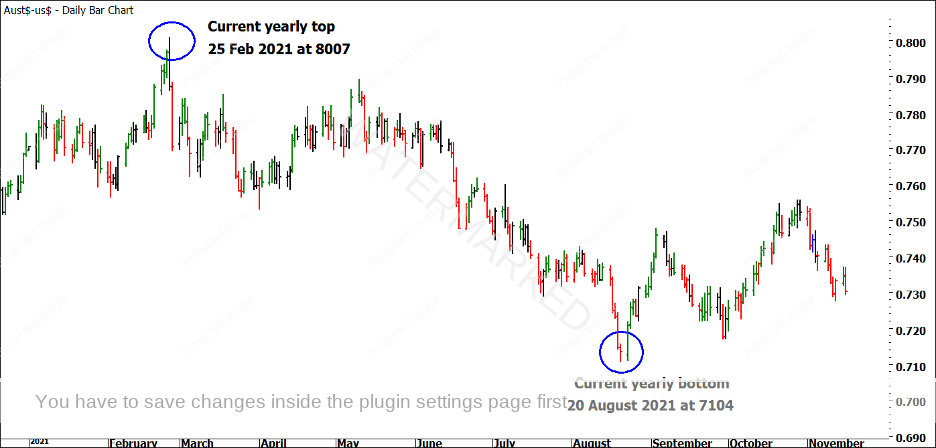A Tale of Two Trades
In the Ultimate Gann Course, David said that many new traders just wanted him to tell them the day of the yearly top and the yearly bottom. They thought that if they could just get these two days of the year right, then trading would be easy – they could just go short at the top and buy back at the bottom. Pretty simple? I thought it was – I was one of the students who used to think this way!
Let’s look at an example. Chart 1 below shows the Australian Dollar (FXADUS in ProfitSource) for 2021, with the current yearly high and yearly low marked. Of course, the market may move lower between now and 31 December, but this will do as an example for now.
Chart 1 – Australian Dollar Current Yearly Top and Bottom
Let’s assume that you were ready for this top to come in, and you entered short on the day of the top, as soon as the Outside Day formed. In other words, you saw the market run up early in the day, and then placed an order to sell if the low of the previous day was broken, forming an Outside Day. In this example, you would be entering short at 7893, and placing a stop at 8008, which is one point above the high. This would give you a risk of 115 points on the trade.
Let’s assume now that you held the short position all the way till the 20 August low, and that you were able to exit the trade at the precise low of 7104. This would give you a profit of 789 points (7893 – 7104) in around six months of trading.
Now don’t get me wrong – a profit of 789 points is nothing to be sneezed at, and I’m sure many of you reading this would happily take 789 points of profit any time! However, it’s not necessarily the size of the move that makes a good trade. Firstly, the trade took six months. During this time, your money could potentially have been used to take other trades. Secondly – the Reward to Risk Ratio (RRR) on this trade was 6.86 to 1 (789 points / 115 points risk), which is the equivalent to the RRR you might expect from two successful ABC trades, which might take a week or two each at most.
It’s worth asking yourself the question now – “is this a fair exchange”? Is it a fair exchange for the time you were in the trade, and is it a fair exchange for the effort put into learning how to call a yearly top and then finding the yearly top and then trading the yearly top?
Let’s contrast this with the 7546 top on 21 October. I was watching for a top around 7541-7542 because of all the price pressure around that level, and I even provided commentary both in the lead up to the top and in the aftermath of the top as the top came in between my recordings for the Ultimate Gann Course Coaching and Active Trader Program Coaching mid-month update videos for my students. In the end, it was only a simple daily swing top, not even a weekly swing top, let alone a yearly top. However, I banked a 7 to 1 RRR profit out of this setup, in less than 48 hours.
Now, out of these two trades – the yearly top of 25 February, and the daily swing top of 21 October, which was the more impressive? In terms of size and prestige, obviously the yearly top was more impressive. That’s the one you’d want to tell your friends or partner about, and that’s the sort of trade you probably dreamt of since you first heard about David Bowden calling yearly tops and bottoms in the market. However, in terms of Reward to Risk – the amount of money that you made compared to the amount of money that you were risking on the trade – both trades are roughly equal. And if you consider the six months required to achieve 6.86 to 1 on the yearly top vs the 48 hours needed to bank 7 to 1 on the second trade, the second trade ended up being the better result.
The point of this article is not to dissuade you from trying to trade yearly tops and yearly bottoms, but to remind you that there are many, many other good trades during the course of a year, and sometimes, if you can get a tight entry, the smaller trades can end up providing the better Reward to Risk Ratio. Think about that for a moment – the size of the risk on entry is more important than the size of the swing turn you are trading.
If you’d like to see EXACTLY how I put this 21 October trade together, I’ll be taking students through this trade on Saturday, 27 November at our upcoming ATPOT Bonus Day – Trading Essentials Webinar, which is a FREE full-day webinar for all students who have the Active Trader Program Online Training (ATPOT). If you already have the Active Trader Program Online Training program, then there is a link in this newsletter to allow you to register. Even if you can’t make the live event, just register using the link and you’ll be able to view the recording later. If you don’t have the new online course and you’re ready to upgrade and also join us on the 27th, then follow the link below to secure your copy.
Active Trader Program Online Training
I’m looking forward to seeing you there on the day!
Be Prepared!
Mat
